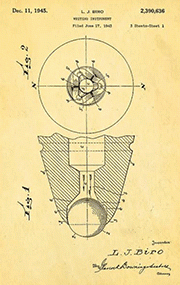E-Archive
Off the Beaten Track
in Vol. 26 - September Issue - Year 2025
The Humble Dot That Rewrote the World

We often believe revolutions are loud—that they come with flags, speeches, or machines roaring through factory doors. But some revolutions begin in silence—like the quiet roll of a tiny ball leaving a trail of ink on paper. This is the story of the ballpoint pen: that unassuming object we twirl, click, chew on, or lose without a thought. But if you follow its journey, you’ll find that it didn’t just change how we write—it changed who could write, how fast we moved, and how easily ideas could flow in a rapidly modernizing world.
Long before plastic pens filled our drawers, writing was a ritual. Ancient Egyptians used reed pens dipped in ink to mark papyrus scrolls. Medieval monks used quills, carefully cut from goose feathers, dipped in ink and steadied by hand. Then came the fountain pen—an upgrade, yes, but still needing refilling and frequent cleaning. Writing, for the longest time, belonged to the careful. To the elite. It demanded posture, patience, and practice. It was elegant, but not effortless. And as the world picked up speed—with machines, trains, newspapers, and war—this delicate tool began to feel out of place.
In the 1930s, a Hungarian journalist named László Bíró found himself frustrated. The ink in his fountain pen was slow-drying, prone to smudging, and often left his notes a mess. He noticed, however, that the ink used in newspapers dried instantly. What if he could use that same ink in a pen? The trouble was, it was too thick for traditional pens. So with his brother György, a chemist, Bíró designed something different—a pen with a tiny metal ball at the tip. As it rolled across the paper, it picked up ink from a reservoir and deposited it in a clean, consistent line. It didn’t need dipping, didn’t smudge, didn’t leak. It just worked. And it worked anywhere.
That small invention found its way into the hands of British Royal Air Force pilots during World War II. At high altitudes, where fountain pens often leaked or failed entirely, the Bíró pen functioned smoothly. Soon, the world wanted in. By the 1950s, companies like Bic began mass-producing ballpoint pens—cheap, reliable, and ready to roll. Suddenly, writing didn’t belong to the few—it belonged to everyone.
That’s what fascinates me. The ballpoint didn’t just change how we wrote—it changed how we lived. No more pausing to refill. No more smudges. You could sign a cheque, jot down a phone number, draft a poem, write a love letter, or draw on a napkin. You could carry it in your pocket, use it on a train, or click it nervously in a meeting. It moved with life. In classrooms, in war rooms, in boardrooms—the pen kept pace with the world.
Even in our digital age, the ballpoint survives. It hasn’t been replaced—only joined by screens and styluses. And maybe that’s because writing with ink is more than just functional. It’s physical. Ink doesn’t ask for permission. It doesn’t have a backspace key. It lows with your thoughts and freezes that moment on paper. There’s no “undo.” There’s only what is.
What this simple tool reminds me is that invention doesn’t always need to be grand or groundbreaking. Sometimes, it’s about noticing what’s not working and quietly making it better. Bíró didn’t set out to change the world. He just wanted a pen that wouldn’t smudge. But in solving that little problem, he gave the world a tool of expression that was fast, democratic, and unstoppable.
I often think about how many ideas throughout history were lost—not because they weren’t brilliant, but because someone didn’t have the right tool at the right time. The ballpoint gave everyone a chance to record, to reflect, to create. It democratized thought in a way that’s easy to miss—precisely because it became so common.
Next time you pick one up, maybe pause. Think of the ball that rolls. The ink that flows. The revolutions that begin without a sound. Because sometimes, the most ordinary things carry the most extraordinary stories.
Rishabh Shah, MFN Trainer and Head of Operations of Daksha: rishabh.shah@daksha.net



























